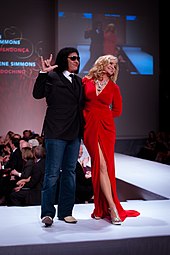| This article includes a list of general references, but it lacks sufficient corresponding inline citations. Please help to improve this article by introducing more precise citations. (February 2010) (Learn how and when to remove this message) |

The ILY is a sign from American Sign Language which, as a gesture, has moved into the mainstream. Seen primarily in the United States and other Americanized countries, the sign originated among deaf schoolchildren using American Sign Language to create a sign from a combination of the signs for the letters I, L, and Y (I Love You).
-
 production
production
-
 SignWriting transcription
SignWriting transcription
-
 ASLwrite transcription
ASLwrite transcription
The sign is an informal expression of any of several positive feelings, ranging from general esteem to love, for the recipient of the sign. A similar-looking but unrelated variation in which the thumb is toward the palm appears in heavy metal music culture as a "horns" hand-sign (though the thumbs extended version is sometimes used) and in college football as a sign of support for various teams including the University of Texas. The University of Louisiana at Lafayette's Ragin' Cajuns Athletics uses the ILY sign to symbolize the initials of the university (UL).
History
Deaf Heritage dates the origin of the ILY to 1905. The sign received significant media exposure with Richard Dawson's use of the ILY in his sign off from each episode of the Family Feud, which he hosted from 1976 to 1985. Presidential candidate Jimmy Carter reportedly picked it up from a group of deaf supporters in the Midwest and, in 1977, during his Inauguration Day parade, flashed the ILY to a group of deaf people on the sidewalk.
The character U+1F91F 🤟 I LOVE YOU HAND SIGN was added to the Unicode standard in version 11.0, released June 2018.
| External videos | |
|---|---|
This followed a campaign to have several common signs added to the Unicode Character Set.
In popular culture
| This section does not cite any sources. Please help improve this section by adding citations to reliable sources. Unsourced material may be challenged and removed. (January 2022) (Learn how and when to remove this message) |

Popular 80s professional wrestler Jimmy Snuka would frequently flash the ILY sign with both hands during his matches and interviews, including while standing on the top rope before delivering his finishing move "Superfly Splash".
The ILY sign is used by the Marvel Comics superhero Spider-Man to activate his web shooters. Additionally Doctor Strange uses it as a means to cast his mystical spells.
Gene Simmons of the rock band Kiss has used the symbol in photoshoots, concerts and public appearances since 1974. He has stated in a television interviews that he was a Marvel comics fan, and was inspired by the Doctor Strange use of the symbol to use it himself in photoshoots. He later (by 1976 or earlier) had black gloves made that lacked index and pinky fingers so that even his raised open hand would emulate the ILY sign.
The ending pose of the popular K-pop song "Boy with Luv" by BTS also incorporates this sign with all the members turning around and raising their right hands in this sign.
Throughout the K-pop song "Fancy", the members of the girl group Twice do this gesture when dancing.
In the anime Love Live!, Nico Yazawa has a catchphrase nico nico nii, and has her own action with it, which incorporates the symbol.
The ILY sign is also a part of the choreography for the song "CASE 143" by Stray Kids (with "143" as a code for "I love you"). It's the title song of their EP MAXIDENT in which they are referencing love as a "maximum accident".
References
- "Sign Language: I Love You". American Sign Language University.
- Jack R. Gannon (June 30, 2012). Deaf Heritage: A Narrative History of Deaf America. Gallaudet University Press. ISBN 978-1563685149.
- "Emoji Recently Added, v5.0". Unicode Consortium.
- "The Unicode Standard, Version 11.0.0 Appendix C" (PDF). Unicode Consortium. Retrieved 2018-06-11.
- More hand gestures. Unicode Consortium.
External links
 The dictionary definition of ILY@Side-PalmForward at Wiktionary
The dictionary definition of ILY@Side-PalmForward at Wiktionary Media related to ILY sign at Wikimedia Commons
Media related to ILY sign at Wikimedia Commons
| Gestures | |
|---|---|
| Friendly gestures | |
| Gestures of respect | |
| Salutes | |
| Celebratory gestures | |
| Finger-counting | |
| Obscene gestures | |
| Taunts | |
| Head motions | |
| Other gestures | |
| Related | |